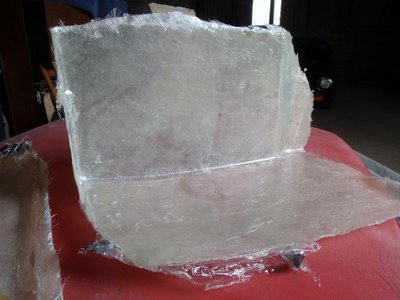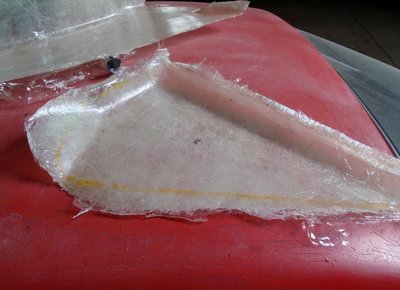Page 1 of 1
Fiberglass release sheet

Posted:
Sat Apr 04, 2015 8:02 pmby Bud English

In doing my fiberglass repairs and modifications I have found these silicone baking sheets to be quite invaluable. Cue derisive laughter...
 http://www.ebay.com/itm/Silicone-Rollin ... 1255343724
http://www.ebay.com/itm/Silicone-Rollin ... 1255343724 is just an example. You can wet out cloth or mat pieces on the sheet or use one on top of your work surface and spilled, hardened, resin comes right off by pulling the sheet over the edge of the table or bench. I covered the last repair layer with the sheet and used it to press out any air bubbles. Finally, I needed a couple of smooth flat panels so I placed one sheet on top of a flat piece of 1/4" steel and laid up the panel to the thickness I wanted, covered it with another release sheet and another flat steel sheet. When hardened, everything cleanly separates and you have a flat panel with good smooth surfaces on both sides. Try it you'll like it.
Here's the safety tip for these sheets. Buy your own. Don't steal hers. Better yet, what I did was buy her some new ones and took her old ones. The fiberglass won't care but she will.

Re: Fiberglass release sheet

Posted:
Sun Apr 05, 2015 4:50 pmby DeanG
Thanks for the tip.
Re: Fiberglass release sheet

Posted:
Tue Apr 21, 2015 10:01 pmby nomad
Those might come in handy, Bud, but a piece of polyethylene will do the same and I have often used plain old saran wrap for a release agent. You can make up a temporary mold out of modeling clay, cover it with saran wrap and pull parts from it. I may use that technique to make a temporary mold for a 26 dash pad if all else fail's.
Kurt
Re: Fiberglass release sheet

Posted:
Wed Apr 22, 2015 12:18 amby Bud English
I use saran wrap and sheet wax as well. The main advantage I found with this is that it doesn't wrinkle. It works best for flat surfaces and slight compound curves and gives a smooth void free final laminate layer. It's not good for tight compound curves.
Re: Fiberglass release sheet

Posted:
Wed Apr 22, 2015 5:35 amby john.p.clegg
aaahhh.... "clingfilm" in the U.K.
John

Re: Fiberglass release sheet

Posted:
Wed Apr 22, 2015 10:37 amby RichC
yes.
My first attempt... I decided to DIY repair the bodged drivers floorwell corner & bootfloor repair from previous driveshaft rotoflex failure .
firstly I decided I'd need a pattern mould from an undamaged shell to support any fibreglass repair attempt.
Having chosen a good donor for making the mould I decided I'd cover the areas with clingfilm .Initially I was wondering how I could hold the clingfilm in place and thought about a light spray of contact adhesive . In the end I turned the donor shell over and used gravity to hold the clingfilm in place ! Then I cut out glassfibre sheet and dabbed polyester resin ontop. shortly afterwards i was able with a palette knife to be able to release the new moulds with no fibreglass remaining on the donor shell .
Not perfectly smooth ... a few clingfilm wrinkles, but good enough for underfloor repairs.
I suppose if i wanted , I could fill in the imperfections in the moulds ...
next step will be to apply a little more clingfilm before taping the moulds in place below the floor areas to be repaired ... I did see that you can buy carnauba wax or PVA release agents to put on moulds but it sounds like a bit of unneccesary faff and expense .......
Rich
Re: Fiberglass release sheet

Posted:
Wed Apr 22, 2015 1:36 pmby Bud English
I've found simple Johnson's Paste Wax, for hardwood floors works well for a release agent on metal, epoxy, or fiberglass based molds. It appears to be available in the UK. Straight carnauba wax and PVA release agents are more expensive and do work well for multiple uses of the same mold but really not needed for one off projects. Stay away from using dry spray lubricants and anything with silicone. They'll make the fiberglass release but will cause you no end of paint problems. Same goes for protective hand creams with silicone ingredients.
I also use aluminum foil HVAC duct ape for a semi rigid temporary mold surface to span holes up to the width of the tape. You stick the tape to the back side of the hole. There is no problem laying up the glass and resin on the adhesive side of the tape as it washes off easily with acetone after the resin hardens.
Being that our cars are made of the stuff, I would think a wiki topic on fiberglass repairs or a thread in the body section would be a valuable addition here.
Re: Fiberglass release sheet

Posted:
Sat Apr 25, 2015 6:33 pmby nomad
Bud, in my youth I made fiberglass gas tanks for racing bikes. The outlet for the fuel petcock i made up out of a piece of aluminum [add lightness!]. The aluminum was drilled and tapped before being laminated in and I would fill the tapped hole with modeling clay with just a dab of PVA applied with a artist brush to the clay. I would drill it out and clean it with a tap after the tank was made. Only leakers I had were bikes that had been dropped on the petcock.
Anyway, what I meant to say was that clay with a generous coat of PVA will pull a good part.
Kurt.
Re: Fiberglass release sheet

Posted:
Sat Apr 25, 2015 7:23 pmby RichC
last weekend i made these to support fibreglass repair

- clingfilm used as release sheet for this mould for rotoflex damage repair

- same for rh front footwell damage
& i'm quite happy how my first diy attempt worked out today
I must have cut about six or seven layers of glassfibre of different shapes & sizes to replace the ground-out portion of the footwell which was about 5/16" thick originally. This was all placed ontop of 1st layer of fibreglass mesh
All i've got to do now is to tidy up the join from underneath.